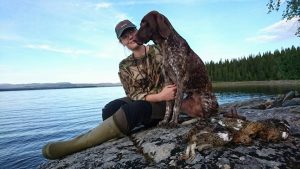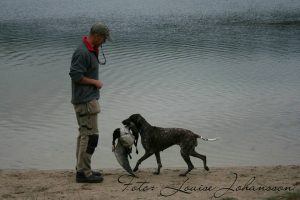Dare fiducia a uno spirito libero
Questo articolo nasce dalla passeggiata in campagna di stamattina, le mie camminate in campagna sono sempre buona fonte di ispirazione!
Oggi ho pensato che, quando esci con un setter inglese, tutti i tuoi sensi devono essere attivi al fine di localizzare il cane che, come la razza comanda, appare e scompare. Lo puoi sentire quando è dietro agli alberi, o quando sta uscendo da un cespuglio; lo puoi vedere quando corre libero si terreni aperti. A volte, quando si rotola in “qualcosa”, ne puoi perfino sentire l’odore. No, non puoi sentirne il sapore, né toccarlo ma, negli anni, hai sicuramente sviluppato un sesto senso capace di dirti dove si trova il cane, cosa sta facendo e da che parte lo vedrai ritornare.
Mentre tenevo le antenne accese, ho incontrato un uomo con una golden retriever. Gli trotterellava accanto, mansueta, tenendo in bocca un grosso ceppo. Mi chiedo se sarei felice con un cane simile o se, al contrario, mi annoierebbe. Poi, quando Briony correva a tutta velocità in una risaia, abbiamo incontrato un runner con un cane corso e con un cane primitivo, più grande di uno shiba e più piccolo di un akita. È rimasto impressionato dal richiamo ma, ancora di più, dalla velocità e dall’ampiezza di cerca. I cani da ferma inglesi, fatta eccezione per il gordon – ogni tanto, sono i cani da ferma più estremi. È difficile per un proprietario di cani da compagnia riuscire a capirli. Restano perplessi quando il proprietario di un setter (o di un pointer) rifiuta di sguinzagliare il cane su un piccolo appezzamento di terreno circondato da strade, spiegando che è troppo piccolo e quindi non sicuro.
Non riescono a capire che quegli spazi sono piccoli: lasciate libero un pastore tedesco o un border collie, saranno sempre attenti, pronti ad obbedire agli ordini, nascono per questo; un dobermann o un rottweiler terranno sempre d’occhio il proprietario, perché il loro istinto gli chiede di proteggerli. Con un setter inglese le cose vanno diversamente: il regalo migliore che possiate fare a un setter è la libertà. Certo, a loro piace anche russare su superfici morbide, gli piace mangiare bene ma, se vuoi davvero far felice il tuo setter… lascialo libero! Il suo muso simpatico diventerà un felice muso simpatico e lui inizierà ad esplorare. Un setter inglese libero non starà a preoccuparsi del padrone. Sono cani che guardano Discovery Channel, sanno benissimo che noi possiamo cavarcela da soli mentre loro sono impegnati a esplorare il mondo, trovare selvatici… ci sono un sacco di cose interessanti in campagna! Dare libertà a un setter inglese è un po’ come portare un maiale in un ristorante all you can eat, o regalare a una donna la carta di credito di qualcun altro! Così tanto entusiasmo mette a dura prova il controllo!
Un setter inglese libero può prestarvi più attenzione se portate un fucile: i cani usati a caccia sanno fare gioco di squadra e la maggior parte di loro è felice di andare a recuperare un selvatico abbattuto. È così che la maggior parte dei cacciatori controlla il proprio setter. Le cose diventano più complicare se non avete armi con voi: il setter (o il pointer), non trae beneficio dalla vostra presenza… ed è questa la parte che mi piace di più! Perché qui entrano in gioco la relazione, l’addestramento e la fiducia RECIPROCA.
Relazione: beh, è elementare, devi avere una relazione con il tuo cane! Lui deve avere fiducia in te (fiducia reciproca, vedi sotto), perché sa che non limiterai la sua libertà, per lo meno non troppo. Lui tornerà da te, o eseguirà i tuoi ordini, e poi sarà di nuovo libero.
Addestramento: l’importanza dell’addestramento non deve mai essere sottostimata. Insegnare a uno spirito libero un richiamo efficace non è facile. Ma sono la prova vivente che l’essere umano modello base può farcela.
Fiducia: sta alla base di tutto. È quello che ti permette di lasciare libero il tuo cane sapendo che tornerà. Devi davvero credere al tuo setter: alcune persone vanno in panico quando vedono quanto forte e lontano questi cani possano andare. Ma se davvero vuoi bene a “qualcuno”, e specialmente se “qualcuno” vive per la libertà… lascialo libero!

